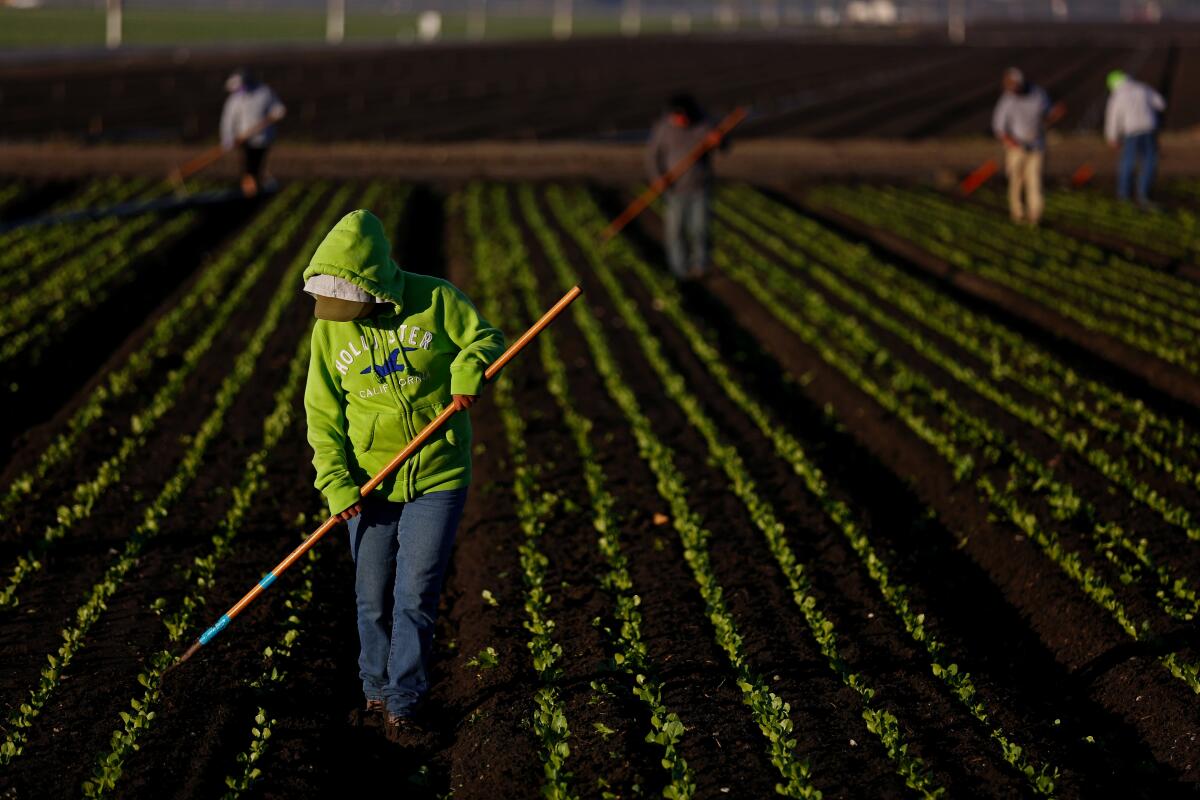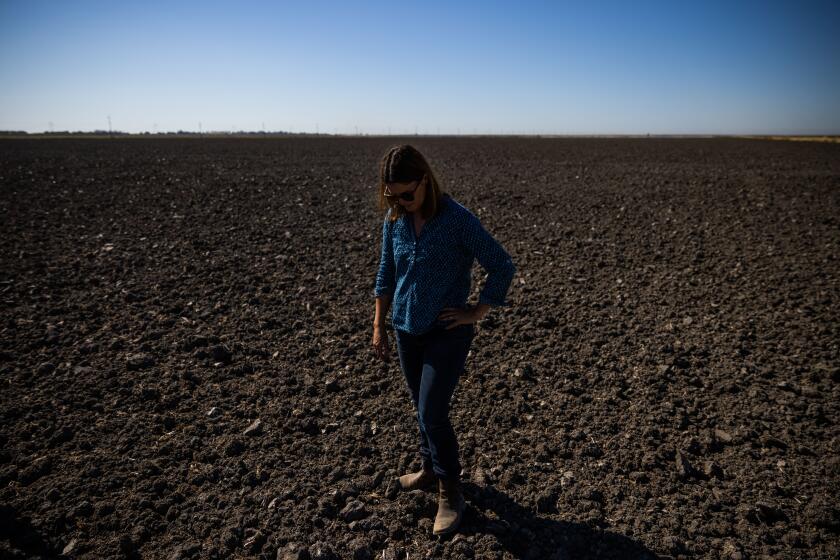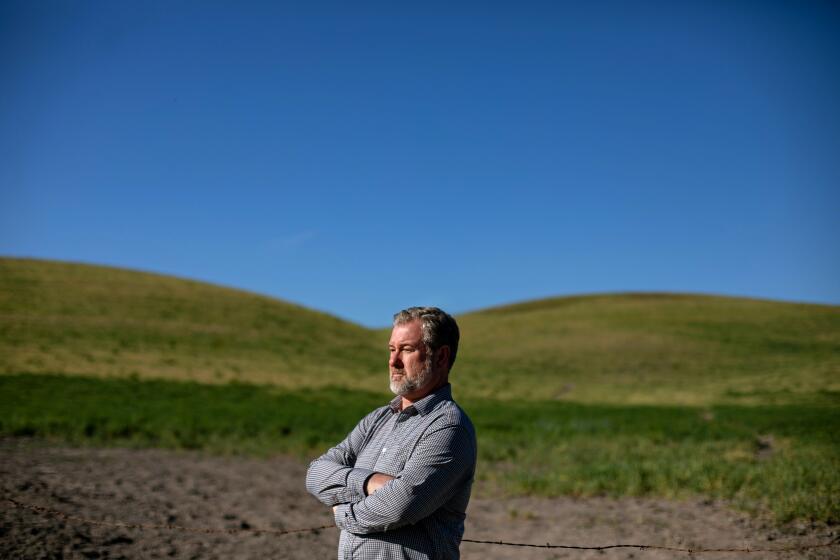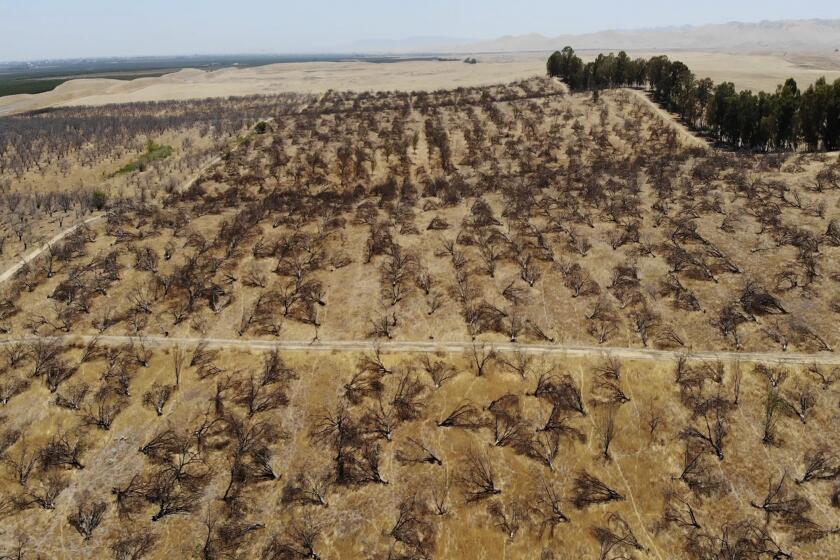Making a salad might be getting more expensive. Could climate change be to blame?

In his nearly four decades of growing lettuce, spinach, kale and other leafy greens in California and Arizona, Tony Alameda has seen plenty of bad years. But lately, he said, there have been many more “noticeably bad” years in a row.
“2022 is probably the worst we’ve seen,” said Alameda, vice president of Topflavor farms, a family operation he runs with his brothers. In October and November, dual outbreaks of a soil-borne disease and an insect-transmitted virus ravaged the Salinas Valley and caused thousands of acres of lettuce crops to wilt.
Now, winter growing schedules and changing weather patterns mean the bad luck has migrated from the Central Coast valley that served as the backdrop for John Steinbeck’s “Of Mice and Men” and other novels to the desert farming regions near the U.S.-Mexico border.
“We’re going from one problem in the north to one problem in the south,” Alameda said. “They’re completely separate problems, but they end up combining to really make a long period of shortage of vegetables.”
As a result, consumers across the country may be seeing stark price increases in lettuce, with the cost of a carton of iceberg skyrocketing from about $20 last December to more than $105 earlier this month, according to data from the United States Department of Agriculture. The Mercury News reported some sellers charging nearly $11 for a single head of lettuce.
A third year of severe drought forced California farmers to leave an estimated 752,000 acres of farmland idle this year, according to a new report.
Experts say bad luck alone may not be to blame, however. The virus, impatiens necrotic spot virus, or INSV, and the disease, Pythium wilt, have been around for years. But warming temperatures driven by climate change are creating more hospitable conditions for thrips, the insect that carries INSV, to thrive.
“Over the last probably 10 years, we’ve seen milder winters, so that’s really allowed the population of thrips to build in our environment here,” said Jennifer Clarke, executive director of the California Leafy Greens Research Program, which operates under the authority of the California Department of Food and Agriculture. Clarke said INSV was first reported in the state’s lettuce around 2006, but was never so big of an issue as to pass any economic threshold.
“Insects are interesting because they really run off of degree days, and so in warmer temperatures it speeds up their life cycles, it speeds up their reproduction,” she said. “If you have cooler weather, it kind of slows everything down. So much of our control is dependent on Mother Nature right now.”
California in particular is plagued by western flower thrips, according to Daniel Hasegawa, a research entomologist with the USDA’s Agricultural Research Service in Salinas. The tiny, slender bugs measure only 1 or 2 millimeters, so they can be difficult to spot and even harder to control, as they can hide in a plant’s folds away from the mist of insecticide.
Hasegawa said the thrips transmit INSV through feeding, much in the same way that mosquitos can transmit pathogens to humans. People won’t get sick from eating INSV-infected lettuce, but the plants will develop brown spots and areas of dead tissue.
“That’s the big question, as to what has changed. This virus has been around, but why has it reached some of the devastating levels that we’ve achieved this year?” Hasegawa said. Based on available weather and insect-monitoring data, “it seems like over the past 20 years, with the warmer temperatures, that the ability of the insects to develop during the wintertime is a lot more likely.”
Bouts of extreme precipitation, along with worsening drought and heat, are creating more of the dangerous dust, experts say.
The presence of Pythium wilt only added to the challenges this year, experts said. The disease is borne in the soil from fungi-like pathogens, which can rot roots and cause infected plants to wilt and collapse. Though many plant varieties are somewhat tolerant of Pythium wilt on its own, INSV can exacerbate it, Clarke said, “so we often see the two of them as a co-occurrence.”
It was the two in tandem that wiped out Salinas crops this fall, said Richard Smith, a researcher with the University of California’s Cooperative Extension program, which places agricultural advisers and researchers in local communities. While both have presented challenges to farmers in the past, something changed in the last few years to worsen the impact on lettuce crops.
“There had been these heat spells that we think have triggered the soil-borne disease,” Smith said. He wondered whether climate change may be a factor.
“That’s a question we have,” Smith said. “All you can do is kind of infer that possibly that’s part of the problem. But one thing is true. Those heat spells were unprecedented. Is that global warming? Who knows? Could be.”
In September, nearly all of California broiled under a record-shattering heat wave that lasted nearly two weeks — the sort of extreme heat event that researchers say will become more frequent and intense as the climate warms.
Increased groundwater demand and less precipitation because of drought have forever altered the state, but several sectors will be hit especially hard.
The shaky fall season was only the start of the challenge this year. Normally around December, the supply of lettuce transitions to southern desert areas around the Imperial Valley. But the disease problem in Salinas meant there was not enough lettuce to carry suppliers through that transition, said Christopher Valadez, president of the Grower-Shipper Assn. of Central California.
What’s more, those desert farms have been experiencing unusually cool weather that is delaying the maturity of the lettuce crops they do have. The Imperial Valley area has seen multiple freeze warnings in recent weeks, and lettuce is sometimes iced over in the mornings.
“Any current shortage in the supply of lettuce is a shortage in the supply of lettuce being produced from the desert production regions, like the Imperial Valley of California and the Yuma, Ariz., production region,” Valadez said, adding that he does expect the market to stabilize and prices to come back down. But that doesn’t solve potential disease and virus problems in the coming Salinas farming season, which starts at the end of February.
Norm Groot, executive director of the Monterey County Farm Bureau, said the organization hasn’t tallied the full loss of crops this year, but in 2021 when there was a similar problem of excessive heat coupled with pests and diseases, there was a loss of $100 million.
“This year, it’s probably going to be more,” Groot said. “If we cannot find a biological or chemical control for either the insect or the disease itself, we’re going to continue to see these problems in our local area. Right now, we have no control of this disease at all.”
The fertile Salinas Valley runs almost the entire length of Monterey County and is separated from the larger, Central Valley by a mountain range. The lettuce crop here is valued at $1.2 billion and makes up a quarter of the agricultural value in Monterey County, Smith said. If the problem persists and growers choose to leave the area to produce lettuce, “that would be a disaster for this community, for the workers and for the retailers.”
Federal officials call upon states to prepare for urgent water cuts — and permanent reductions as a hotter, drier climate shrinks the Colorado River.
Smith said experts are working to find a solution to the shortages. So far, researchers and seed breeders are finding that there are varieties of lettuce that have some resistance to disease, he said.
“That looks promising,” he said, though he noted that doesn’t solve the issue of other diseases or excessive heat. “We’re coming at it from every angle we can think of.”
Alameda, the Salinas farmer, called the confluence of problems this year “a perfectly bad storm,” and said it could take some time for prices to even out at the consumer level. He also worried that another climate change-driven challenge — drought — could soon affect his ability to farm. California and Arizona both rely heavily on water from the Colorado River, which is shrinking to such perilous lows that officials may soon slash supplies.
“That is looming in the very near future — when we will be having to make a choice, when I’ve only got so many gallons of water, how am I going to best maximize the economic opportunity with that water,” he said. “That’s got nothing to do with what we’re dealing with at this time, but it’s looming very close, very close, if the rain doesn’t come back.”
Still, he remained optimistic that genetic improvements, including new disease-resistant varietals of lettuce, will help farmers weather the current challenges.
“Salinas is the salad bowl of the world,” he said. “I think we will continue to solve the problems, like we have in the past with other diseases, to manage to get through it and continue to thrive. I’m 98% confident that’ll happen. But there’s 2% of me that says, keep your eyes wide open.”
More to Read
Sign up for Essential California
The most important California stories and recommendations in your inbox every morning.
You may occasionally receive promotional content from the Los Angeles Times.
















